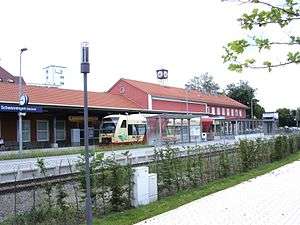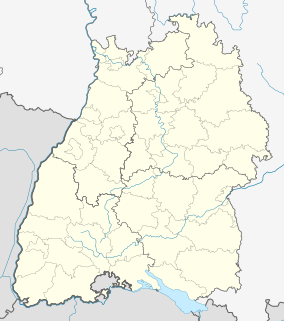Schwenningen (Neckar) station
Schwenningen (Neckar) station is one of two stations in Villingen-Schwenningen in the German state of Baden-Württemberg. The other is Villingen (Schwarzwald). Schwenningen owes its connection to the railway to Johannes Bürk, who had demanded a route through Schwenningen to promote the local watch industry, which included his own factory. The original plans involved a route through Niedereschach.[3] The station is located at the Neckar, south of central Schwenningen. It is located at 695 metres above sea level on the Rottweil–Villingen railway. Originally the station was 540 metres long and up to 56 metres wide. The complex included a station building and a goods shed.[4]
| Through station | |
 Ringzug train in Schwenninger station | |
| Location | Erzberger Str. 20, Villingen-Schwenningen, Baden-Württemberg Germany |
| Coordinates | 48°03′36″N 8°32′08″E |
| Line(s) | Rottweil–Villingen |
| Platforms | 2 |
| Other information | |
| Station code | 5752[1] |
| DS100 code | RSCV[2] |
| IBNR | 8005490 |
| Category | 6[1] |
| Website | www.bahnhof.de |
| History | |
| Opened | 1869 |
| Location | |
 Schwenninger Location in Baden-Württemberg  Schwenninger Location in Germany  Schwenninger Location in Europe | |
The station promoted the economic boom of Schwenningen as an industrial city. The watch industry attracted workers from far away, some from the Stuttgart area. That explains why 436,410 passengers were counted in 1907, as Schwenningen had developed from the village into a city by that time.
History
The station building was completed in 1872.[5]
As a result of the industrial importance of Schwenningen, the station was repeatedly targeted by Allied air raids during World War II.
A goods yard was once located on the opposite side of the tracks, but west of the entrance buildings. After the remediation of the area and the defusing of the last known unexploded ordnance, the venue was used for the Villingen-Schwenningen state garden show (Landesgartenschau) in 2010.
The station includes a historic signal box, which was built in 1869. This allowed the route to be set by means of mechanical levers. It is located opposite the entrance building near the Neckar. The building is no longer used for railway operations, but is heritage-listed. During the garden show, the pedestrian underpass that once connected the entrance building with Neckarstraße was shortened. It now extends only to the rear of the second platform and the signal box, which was secured with a new base.
References
- "Stationspreisliste 2020" [Station price list 2020] (PDF) (in German). DB Station&Service. 4 November 2019. Retrieved 15 November 2019.
- Eisenbahnatlas Deutschland (German railway atlas) (2009/2010 ed.). Schweers + Wall. 2009. ISBN 978-3-89494-139-0.
- "Zeittafel für Schwenningen bis 1972" (in German). Retrieved 14 June 2016.
- Georg von Morlok (1890). 'Die Königlich Württembergischen Staatseisenbahnen : Rückschau auf deren Erbauung während der Jahre 1835 - 1889 unter Berücksichtigung ihrer geschichtlichen, technischen und finanziellen Momente und Ergebnisse (in German). p. 138.
- Gerhard Jehle (2001). Stätten der Arbeit, Stätten der Verwaltung, Wohnstätten: Die Industriearchitektur in Villingen und Schwenningen bis 1945 (Hochbauten) (PDF) (in German). p. 133. (dissertation)
Sources
- Harald Lode (1992). Der Bahnhof Schwenningen a. N. in Geschichte und Gegenwart: Festschrift zum Bahnhofsfest am 23. Mai 1992 (in German).
External links
- Gerhard Jehle (2001). Stätten der Arbeit, Stätten der Verwaltung, Wohnstätten: Die Industriearchitektur in Villingen und Schwenningen bis 1945 (Hochbauten) (PDF) (in German). (dissertation)